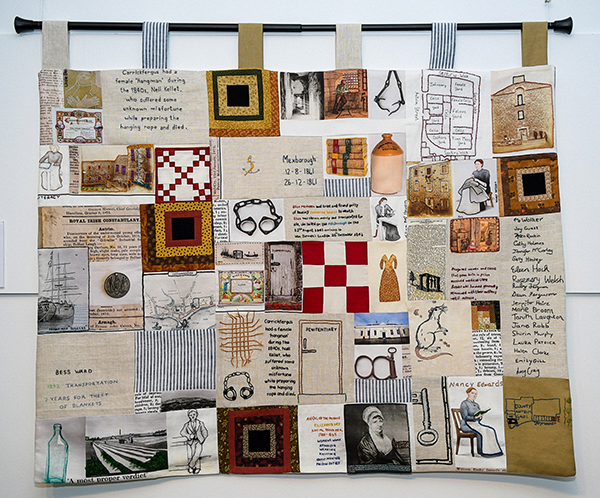A MOST PROPER VERDICT—AN EXHIBITION EXPLORING ATTITUDES TO CRIME AND PUNISHMENT IN NINETEENTH-CENTURY MID- AND EAST ANTRIM
Published in Issue 3 (May/June 2022), News, Volume 30Mid-Antrim Museum, Ballymena, until 5 June 2022
Larne Museum, 4 July–26 August 2022
enquiries@midandeastantrim.gov.uk
By Rachel Newell
Lizzie Barr was tried for the murder of Adam Maxwell in front of a full court-house in Larne, Co. Antrim. Local interest and a dramatic story meant that many others waited outside, unable to watch the unfolding drama. The victim, Maxwell, was a married man who had been visiting a brothel. Barr told him off for how he was treating his wife. The two fought, and in the course of their disagreement Barr fatally stabbed Maxwell. He died the next day. It was 1894 and true crime fascinated the public in the same way that it does today. Open trials, like this one, allowed locals into courts, and newspaper reports kept the entire country informed of particularly scandalous cases. Over a century later, the case still captures the attention and the imagination of locals and visitors as part of A most proper verdict, an exhibition on crime and punishment by the Mid and East Antrim Museum and Heritage Service, in association with Queen’s University, Belfast.
Throughout Ireland during 1894 there were 5,100 charges made before the two highest courts, the assizes and the quarter sessions. Seventeen related to the murder of an individual over one year of age. Women were less likely than men to be convicted of most serious violent crimes, and were less likely to be charged with or convicted of a crime in general. In academic literature, this has often meant that women have been occluded from discussions of criminality, particularly if statistically based. A most proper verdict avoids this, centralising stories, individual experiences and women in portraying the history of crime.
A most proper verdict discusses the varying degrees of punishment, including execution, transportation, prison sentences and fines. Photographs from Carrickfergus Gaol before its demolition line the walls, and life inside the prison is explored through the words of inmates. These statements come alongside displays of handcuffs, manacles, leg irons and the key to the condemned cell, giving physical reference points to a past which many visitors might find hard to picture. Alongside these items, the discussion of crime and criminals helps to place unusual crimes like murder, with their harsh penalties, in context. The majority of crimes committed in Antrim, and in Ireland, involved drunken behaviour, common assault and theft. The exhibition draws out the experience of poverty and the role of alcohol alongside the opportunities for theft provided by the local linen industry.
A temperance medal from Larne alludes to the influence of middle-class social reformers who tried to tackle crime and disorder in society. They did so by imposing a morality based on their own experiences on the working class. Temperance was one aspect owing to the link that was often made between criminality and alcohol consumption. The communion set from Ballymena Workhouse, also displayed in the exhibition, represents another. This imposition of middle-class values on working-class people, who often had very different lives, could be detrimental. It helped to create distinctions between the so called ‘deserving’ and ‘undeserving’ poor, influenced a culture of shame around pre-marital sex and stoked moral panics over the fate of the nation, all of which had an impact on the lives of ordinary working-class people. However, the exhibition also discusses how social reformers were changing the prison system by the end of the nineteenth century, as prevention and reform became increasingly more important. These changes continued into the twentieth century with the First Offenders Act of 1907.

Above: This commemorative quilt, created through a series of public workshops with a group from Carrickfergus and the surrounding area, forms part of the exhibition. (Mid and East Antrim Museum and Heritage Service)
A commemorative quilt, created through a series of public workshops with a group from Carrickfergus and the surrounding area, forms part of the exhibition. It draws the themes of the exhibition together, highlighting harsh punishments and unique stories that stuck with participants through each patch. The quilt demonstrates what this exhibition does so well in bringing unrepresented stories to a wider audience and the importance of the visibility of ordinary people and their stories from the past. Most of all, it highlights the different things that each visitor can take from A most proper verdict and the personal experiences of our local histories.
Rachel Newell is a Ph.D researcher at Queen’s University, Belfast, investigating female criminality and society in Ulster between the 1880s and 1920s.
















